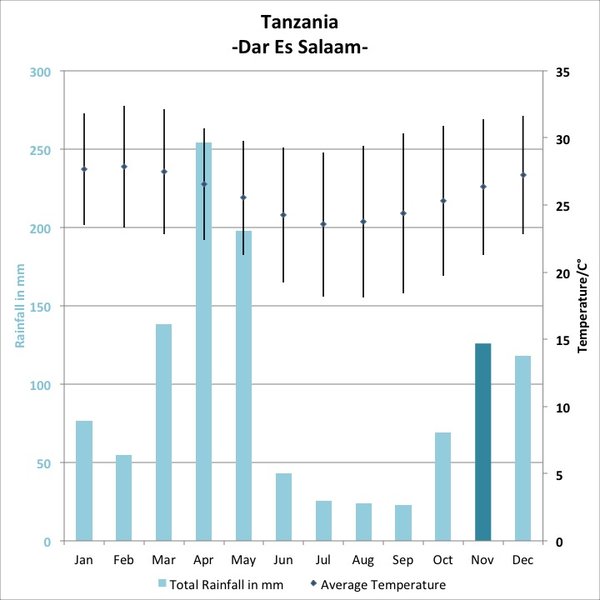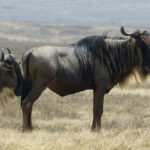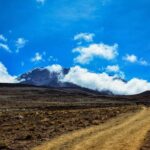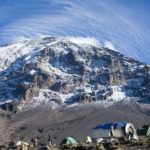Ever wondered why the Serengeti plains seem like a sprawling canvas of gold during some parts of the year and verdant green at others? This transformation is a testament to Tanzania’s fascinating climate characterized by distinct wet and dry seasons. The climate varies significantly across its regions making it a land of diverse weather patterns.
Tanzania experiences two primary seasons: a long rainy season from March to May and a short rainy season in November and December. The country’s expansive geography results in varying weather patterns, with coastal areas being more humid and the central highlands experiencing cooler temperatures. For optimal travel experiences, June through October, the dry season, is often recommended, coinciding with the great migration and other wildlife spectacles.
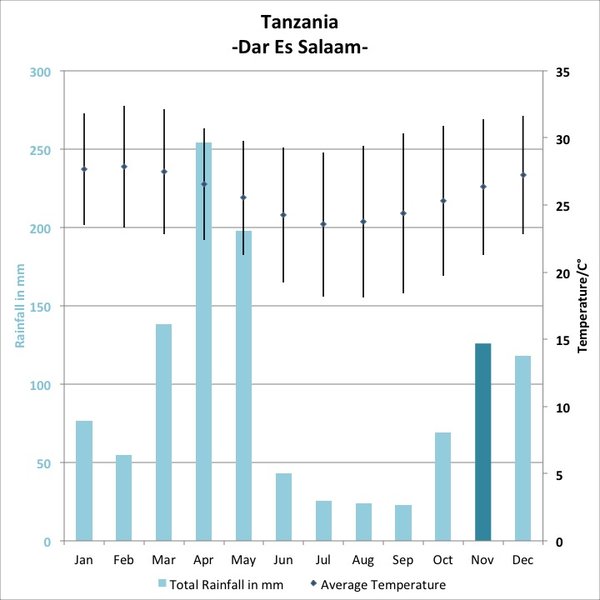
Overview of Tanzania’s Climatic Conditions
Tanzania’s climate is as diverse as its landscapes. Ranging from coastal areas to high-altitude regions, weather patterns vary significantly. The country boasts a tropical climate near the coast, featuring high temperatures and humidity. Conversely, the highlands experience more temperate conditions, with cooler temperatures throughout the year. This diversity makes Tanzania an interesting destination for travelers year-round.
One remarkable feature of Tanzania is its two distinct rainy seasons. The long rains occur from March to May, while the short rains come in November and December. These rainy periods rejuvenate the flora, making the landscapes lush and beautiful. However, they can also lead to challenging travel conditions. Many tourists plan their trips around these seasons to ensure a smooth travel experience.
In contrast, the dry season from June to October is ideal for wildlife viewing. During this period, the grasses are shorter, making it easier to spot animals. National parks like the Serengeti offer some of the best wildlife experiences during these months. The lack of rain also means fewer insects, making it more comfortable for outdoor activities. This season is particularly popular for safari enthusiasts.
The coastal areas, including Zanzibar, experience more moderate climatic variations. Temperatures remain relatively stable, with slight increases during the dry seasons. Coastal regions can be more humid, offering different yet equally compelling attractions. Water activities are popular, especially during the dry seasons. Many travelers find the coastal climate perfect for relaxation and adventure.
Understanding the geographical diversity and its impact on local climates
Tanzania’s geographical diversity is astonishing, with landscapes ranging from mountains to plains. Mount Kilimanjaro, Africa’s highest peak, has its own microclimate, featuring chilly temperatures at higher altitudes. The slopes of Kilimanjaro experience tropical rainforests, which receive consistent rainfall throughout the year. Conversely, the lowland areas surrounding the mountain have savannah-like conditions. This variety in landscapes creates unique weather patterns that tourists can explore.
The Great Rift Valley runs through Tanzania, significantly influencing its climate. This geographical feature causes variations in elevation across the country, leading to diverse weather conditions. For instance, areas within the Rift Valley can be quite arid. In contrast, the surrounding highlands benefit from cooler temperatures and more frequent rainfall. This variation affects agriculture, wildlife, and human settlements in various ways.
Coastal regions, including the islands of Zanzibar, experience warm and humid weather. The Indian Ocean strongly influences these areas, offering more stable and higher temperatures year-round. This climate is ideal for beach activities and water sports. However, the humidity can be intense, particularly during the rainy seasons. The coastal belt is also subject to occasional tropical storms.
The inland areas, such as the Serengeti and Ngorongoro Crater, offer a different climate. These regions experience a tropical savannah climate with distinct wet and dry seasons. During the dry season, wildlife congregates around water sources, providing excellent opportunities for safaris. The wet season sees the landscape transform into a lush, green environment. This diversity ensures that Tanzania has something to offer everyone.
Seasonal Shifts and Weather Patterns in Tanzania
Tanzania experiences two main rainy seasons and two dry seasons. The long rains, also known as the “Masika,” fall between March and May. Heavy downpours are common during this period, significantly affecting travel conditions. The short rains, termed “Vuli,” occur in November and December. These rains are less intense but still impact daily life and tourism activities.
The dry seasons are a highlight for many visitors due to their clear skies and predictable weather. From June to October, Tanzania experiences its main dry season. During this time, temperatures are warm, and the landscape can become quite dusty. This period is ideal for wildlife safaris as animals gather around shrinking water sources. A shorter dry season also occurs from January to February, offering another window for dry weather tourism.
A unique feature of Tanzania’s climate is its microclimates, especially in areas with varying altitudes like Mount Kilimanjaro. In lower regions, temperatures are warmer and more consistent. However, as one ascends, the climate changes drastically. It can even snow at the summit, providing a stark contrast to the tropical conditions at the base.
Different regions of the country experience varied climatic conditions. For example, the coastal areas enjoy a tropical climate, while the central plateau encounters a more arid setting. The highland areas benefit from a more temperate climate with cooler temperatures throughout the year. This geographical diversity ensures that Tanzania can cater to a wide range of climatic preferences.
Optimal Travel Times for Tanzania’s Major Destinations
Planning the perfect trip to Tanzania involves understanding the best times to visit various regions. The Serengeti National Park is at its prime from June to October. These dry months make it easier to spot wildlife, especially during the Great Migration. Many tourists flock to see millions of wildebeest and zebras on the move. Safaris during this period offer the most spectacular views and photographic opportunities.
If climbing Mount Kilimanjaro is on your bucket list, consider visiting from January to mid-March or June to October. These months provide the most favorable trekking conditions. Clear skies and mild temperatures make the climb more enjoyable. The rainy seasons are less ideal due to slippery paths and lowered visibility at higher altitudes. This ensures a safer and more memorable adventure.
Zanzibar, with its stunning beaches and vibrant culture, is best enjoyed from June to October. This dry season ensures perfect beach weather. It’s less humid, making it comfortable for sunbathing, swimming, and exploring the island. Water activities, such as snorkeling and diving, are also popular during these months. The crystal-clear waters offer breathtaking underwater views.
Ngorongoro Crater, another must-see destination, is ideal to visit year-round, though the dry season from June to October is often preferred. During these months, wildlife converges around the few remaining water sources. This makes game viewing easier and more predictable. The cooler temperatures at higher altitudes are also a relief from the heat of lower plains. Additionally, the lush scenery after the rainy season offers beautiful landscapes.
For those interested in the cultural richness of Tanzania, the months of January and February are great to visit the mainland. Festivals celebrating local traditions often take place during these months. You can experience the vibrant life of cities like Dar es Salaam and Arusha. The weather remains warm but more bearable compared to the peak summer months. This allows for enjoyable city tours and cultural explorations.
Key Takeaways
- Tanzania has two main rainy seasons: March-May and November-December.
- The dry season from June to October is ideal for travel.
- Coastal regions are warm and humid throughout the year.
- Highland areas enjoy cooler, more temperate climates.
- Optimal travel times balance safaris and beach relaxation.

